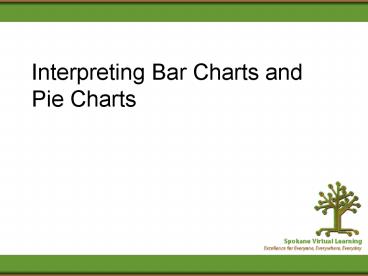Interpreting Bar Charts and Pie Charts PowerPoint PPT Presentation
Title: Interpreting Bar Charts and Pie Charts
1
Interpreting Bar Charts and Pie Charts
2
Interpreting Bar Charts and Pie Charts
- In this presentation
- Bar charts
- Pie Charts
- Interpretation Guidelines
3
Bar Charts
- Bar Charts are used to display qualitative data
- Bar charts may display
- Counts (or frequencies)
- Percentages
- Proportions
- This allows comparison between categories.
4
Bar Charts
- The vertical scale is the frequency, relative
frequency, or percentage. - This is critically important to recognize and
should be labeled. - Frequencies are raw counts. That is, how many
individuals prefer each of the colors. - Relative frequencies are really proportions
(usually decimals). To find the relative
frequencies, divide the frequency by the total
(for red, 11/25 or .44). - Percentages are relative frequencies expressed as
percentages (for red, 44). - See the example.
5
Bar Charts
- The horizontal scale shows the different
categories (sometimes multiple categories are
lumped together into an other category).. - All bars should have the same width.
- There are gaps between the bars (since there is
no connection between them) - Categories may be listed in any order.
- More complicated bar charts exist (such as
stacked or side-by-side).
6
Bar Chart Example
Back to slide 4 on Bar Charts
7
Pie Charts
- A circle is divided up proportionately to show
what percentage of the total each category
represents. - They convey information regarding only the
relative size of categories (because of this,
they may mislead as totals remain unknown).
8
Pie Chart Example
9
Interpretation Guidelines
- Carefully read all labels (title, axes, bars, pie
segments, etc.) including the units and scale (be
sure to note the scales starting point). - Identify (if possible) the source of the data. Is
there sufficient reason to suspect the source may
be attempting to persuade? In what way?
10
Interpretation Guidelines
- Consider and watch for extreme values or other
possible anomalies. - Do the bars or pie sections represent counts or
relative counts? - If there are multiple displays, are their scales
and axes consistent?
11
Interpreting Bar Charts and Pie Charts
- This concludes the presentation
PowerShow.com is a leading presentation sharing website. It has millions of presentations already uploaded and available with 1,000s more being uploaded by its users every day. Whatever your area of interest, here you’ll be able to find and view presentations you’ll love and possibly download. And, best of all, it is completely free and easy to use.
You might even have a presentation you’d like to share with others. If so, just upload it to PowerShow.com. We’ll convert it to an HTML5 slideshow that includes all the media types you’ve already added: audio, video, music, pictures, animations and transition effects. Then you can share it with your target audience as well as PowerShow.com’s millions of monthly visitors. And, again, it’s all free.
About the Developers
PowerShow.com is brought to you by CrystalGraphics, the award-winning developer and market-leading publisher of rich-media enhancement products for presentations. Our product offerings include millions of PowerPoint templates, diagrams, animated 3D characters and more.

